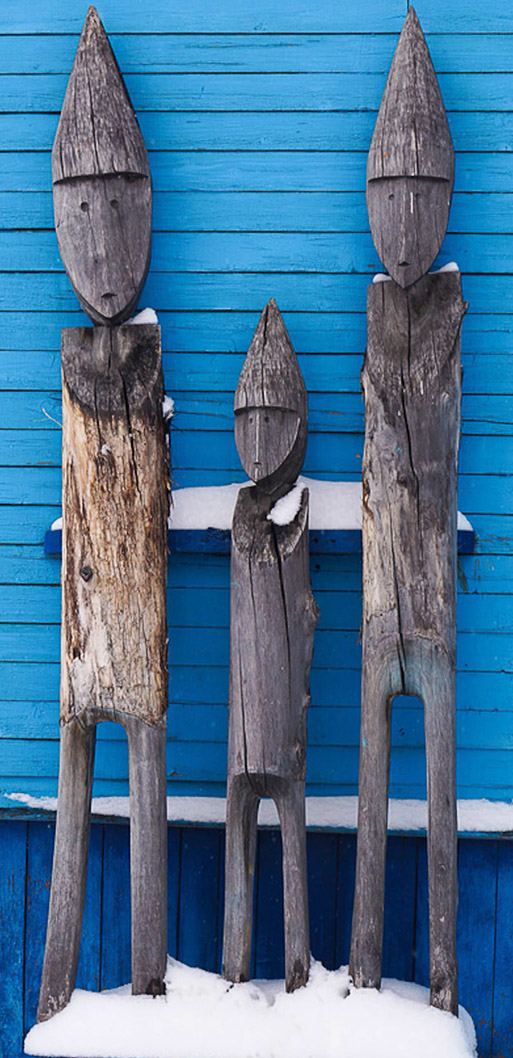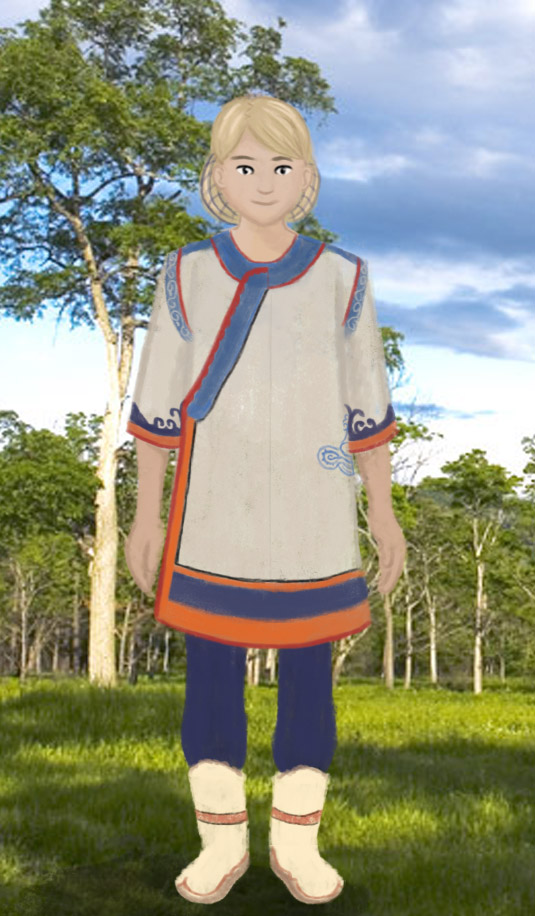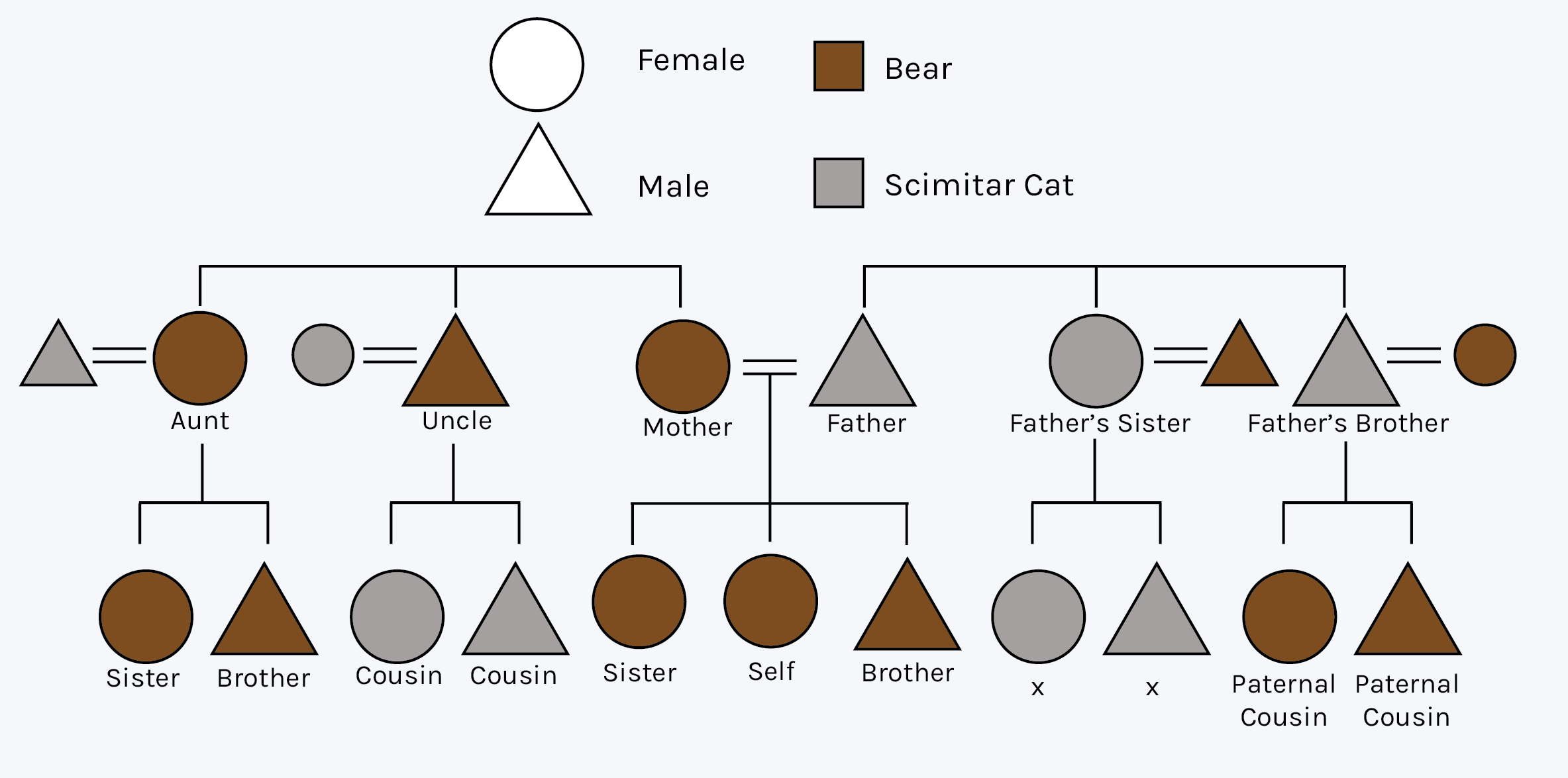Dàni
The Dàni people along the southern coast will tell you they are the people of the bear and the scimitar cat, but one whiff of their fish-skin coats reveals the truth. They are fishermen at heart, and their dreams of imperialism are laughable. If I were a salmon, I might begin worrying about our neighbours.
The Dàni people live along the southern coast of Kaabara, in a strip of forest and wetland south of the Lurun Mountains. For centuries, their economy has been based around fish. The many rivers, streams, and wetlands in the region supply more than enough.
They take canoes out into the marshes in the warmer months. In the winter, the lakes and marshes freeze over. Families often leave their villages to set up camps directly on the ice for several long weeks of ice fishing.
They're well known for their use of fish skin leather in their clothing, which is commonly mocked by outsiders. Fish skin, though, is durable, waterproof, and quite soft once properly treated. Still, the western Dàni, who are desperatly trying to modernize and become major players on the global stage, have begun to shun the traditional clothing to be taken more seriously by foreign diplomats. Fish skin has come to be seen as a peasant's material in the west, though it's still embraced by the more traditional east.
They take canoes out into the marshes in the warmer months. In the winter, the lakes and marshes freeze over. Families often leave their villages to set up camps directly on the ice for several long weeks of ice fishing.
They're well known for their use of fish skin leather in their clothing, which is commonly mocked by outsiders. Fish skin, though, is durable, waterproof, and quite soft once properly treated. Still, the western Dàni, who are desperatly trying to modernize and become major players on the global stage, have begun to shun the traditional clothing to be taken more seriously by foreign diplomats. Fish skin has come to be seen as a peasant's material in the west, though it's still embraced by the more traditional east.
Religion
About 300 years ago, Timilism made it to the Dàni region via Mangzmat. The religion has slowly moved east, supplanting the native shamanist religion. Dàni people in the east still maintain the old traditions, while those in the west are trying to rapidly modernize and stand as an equal compared to the powerful Taalorang Empire to the north. This has created two distinct groups of Dàni: the modernizing west and the traditional east.Social Structure
They are born into one of two sides: the bear or the scimitar cat. The side you are on is dependant on your mother, and you may only marry someone from the opposite side. Marrying someone from the same side is taboo and considered immoral and gross. You keep your side for life; nobody changes sides upon marriage. Within the sides are numerous clans. The names of the clans come from their origins, referring to whatever event brought them together and defines them as separate from the others. For example, the Acorn clan origin story is about planting a tree and building their first village around an ever-growing oak, and the Mammoth clan are allegedly the first people to tame a mammoth. A small village might consist of only one clan, larger towns have two or three clans represented, and the major cities are more mixed. You belong to whatever clan your mother was in. Clans contain families, which generally live close in clustered homes and are closely related by blood. The head of the family is generally the oldest member, and could equally be a man or a woman. After marriage, a couple generally lives in the vicinity of the woman's family, though in the modernizing cities, this pattern is breaking down.Kinship
The terms used are the translations that are used throughout articles about them, but in their own language, they have distinctive terms for things like "Father's Brother" that are different than "Mother's Brother". Inheritance is passed through the female line. So, a man's title and possessions pass to their sister's children, not their own. A woman's title and possessions pass to their own children. Same-sex couples rarely have children, but they are usually the ones to adopt orphaned children or foundlings. The children can be ceremonially adopted into one of the parents' clans, but they remain bear or cat.Naming Traditions
Other names
Their names use the patter Clan Name + Given Name + Family Name
Culture
Major language groups and dialects
They speak the Dàni language. The western dialect has many loanwords from Baanang, while the eastern dialect is more "pure". Eastern dialect is considered low-class, stupid, and rural sounding to the westerners.
For most of history, they had no written language. Around 200 years ago, a scholar created a system to use the Baanang alphabet for Dàni, though it is sometimes messy due to the different sounds and syllable structures. The difficulty of this system is part of the reason why only elites are literate.
Funerary and Memorial customs
A person is not their body. A person is a soul. When a person dies, the body is nothing but the empty husk left behind. It is taken into the wilderness and left there, so that it may feed the animals and return to the earth.
The true memorial comes from the wooden doll carved by the deceased's wife, mother, sister, daughter, or another women of their clan. Ideally the doll is prepared before death so that the soul can transfer to it immediately, but in cases of sudden death, it is acceptable to be made within a day.
As long as a person's soul has the doll as an anchor, they can pass freely from the spirit world (where all souls return after death) to the living world to watch over their family. If the doll is destroyed, the doorway between the worlds is closed to that person forever. If they were in the living world when this happens, they are no longer able to get back to the spirit world and will be doomed to remain as a ghost. Hopefully, they were in the spirit world at the time, and can find eternal rest even if they can no longer visit their family. Naturally, destroying a doll is a horrible crime and deeply taboo.
Dolls are kept in the deceased's family home. Every home has a small shrine where they keep the dolls of their dead relatives. If a shrine becomes too crowded and the dolls belong to relatives so old no one living remembers them, they are taken to the village shaman to be buried in the village holy ground. Underground, they will be safe.
The true memorial comes from the wooden doll carved by the deceased's wife, mother, sister, daughter, or another women of their clan. Ideally the doll is prepared before death so that the soul can transfer to it immediately, but in cases of sudden death, it is acceptable to be made within a day.
As long as a person's soul has the doll as an anchor, they can pass freely from the spirit world (where all souls return after death) to the living world to watch over their family. If the doll is destroyed, the doorway between the worlds is closed to that person forever. If they were in the living world when this happens, they are no longer able to get back to the spirit world and will be doomed to remain as a ghost. Hopefully, they were in the spirit world at the time, and can find eternal rest even if they can no longer visit their family. Naturally, destroying a doll is a horrible crime and deeply taboo.
Dolls are kept in the deceased's family home. Every home has a small shrine where they keep the dolls of their dead relatives. If a shrine becomes too crowded and the dolls belong to relatives so old no one living remembers them, they are taken to the village shaman to be buried in the village holy ground. Underground, they will be safe.

Nanai's Idols by Alexey Gureev
Ideals
Beauty Ideals
They prefer lighter skin, round faces, and rosy cheeks. Aristocratic women often use rouge on their cheeks to accomplish this. Dàni tend to have lighter brown to dirty blond hair, and bright blond is a rare but desires shade. Having very dark eyes in contrast to light hair is considered very beautiful.
Gender Ideals
Traditionally, the Dàni didn't recognize significant differences between men and women. Their primary source of food was fishing, an activity that does not require significant strength, so men and women worked together to provide for their families. Once a child is past the stage of nursing, women are expected to return to working outside the home alongside their husbands, with older members of their clan watching the children.
The primary division is between the two sides. Scimitar Cats are the political leaders, with the domain of government, decision making, and are in charge. Bears are supposed to be more spiritual and oversee religion. The traditional shamans were all bears, and the role was passed from mother to daughter. Ceremonies are always conducted by bears and the bear parent is expected to protect the spiritual well-being of their families.
Scimitar Cat men and women work in tandem in government, with no preference shown in inheritance or promotion to administration jobs. Men and women of the Bear side are very rarely in any administrative role, and the Scimitar Cat parent is the head of household.
Related Organizations




